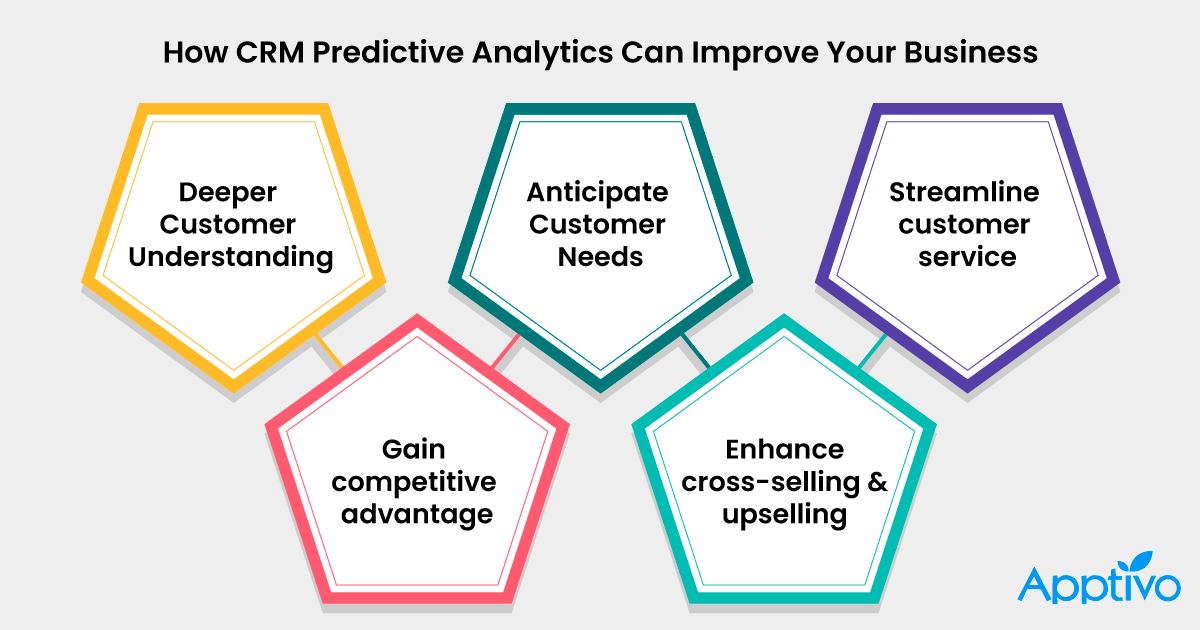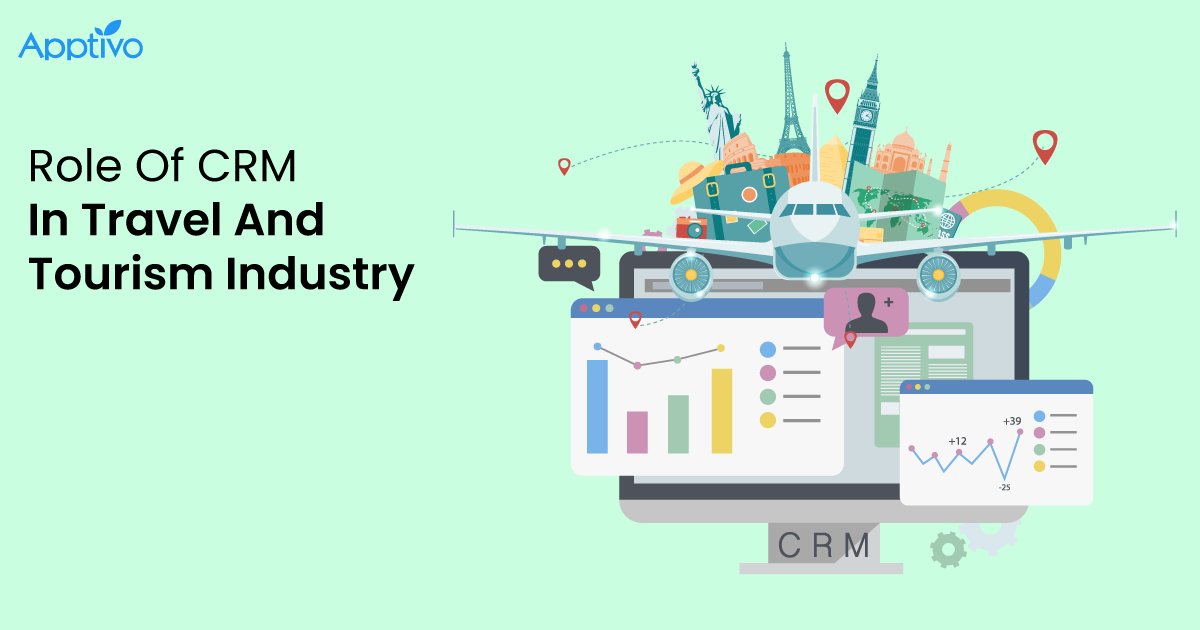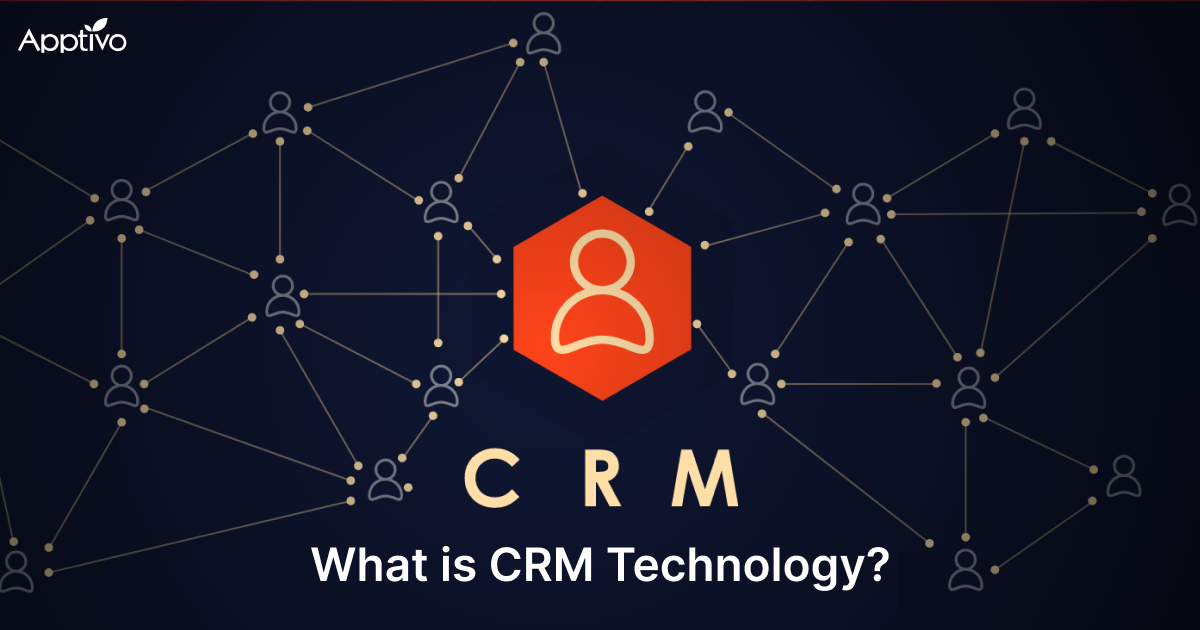 |
1. What Is Predictive Analytics?
2. How Does Predictive Analytics Work?
3. Predictive analytics and other types of business analytics
4. Examples of Predictive Analytics
5. Predictive Analytics Empowers CRM
In the world of customer relationship management (CRM), the age-old wisdom “forewarned is forearmed” holds truer than ever. Imagine having a crystal ball that could reveal your customer’s desires before they even voice them – that’s the potential of predictive analytics in CRM. This blog sets sail into the topic of predictive analytics, which aids in the progress of any company.
What Is Predictive Analytics?
Predictive analytics, an advanced form of analytics, forecasts future outcomes using historical data, statistical modeling, data mining, and machine learning. Companies use this method to detect possible hazards and possibilities by analyzing large amounts of data spread across multiple repositories within the organization, such as log files, photographs, and videos. Deep learning and machine learning algorithms are used by data scientists to gain useful insights and forecast future events. In this process, techniques such as logistic and linear regression models, neural networks, and decision trees play an important role. As they learn from initial data patterns, these models continue to evolve, yielding more predictive insights.
How Does Predictive Analytics Work?
Predictive analytics makes forecasts about future outcomes by using historical data and statistical modeling, data mining techniques, and machine learning algorithms. Here’s a detailed breakdown of how it works:
Define the problem
Take Maersk, which wishes to optimize their delivery routes in real time. They have a vehicle fleet and must identify the most efficient routes to deliver packages to various locations during the day. Predictive analytics can assist in resolving this issue by utilizing past data on traffic patterns, weather conditions, and delivery schedules to build a model that forecasts the quickest and most cost-effective routes for each truck. This allows the organization to save time and money on fuel while also improving overall delivery performance.
Acquire & organize data
To create predictive analytics models, a company must first collect and organize relevant data. This data can come from a variety of sources, including historical data acquired over time or a continuous stream of real-time data derived from client interactions.
Let’s consider Uber as an example, which collects data from its mobile app, such as ride requests, pickup and drop-off locations, driver characteristics, and trip lengths. This data is regularly updated when users request rides and drivers accept them. The organization would need to discover and collect these data flows in real time. They would then organize and store this data in a centralized repository, making it conveniently accessible for further study.
With this organized data, the company can improve its services through predictive analytics. They may, for example, create algorithms to estimate ride demand in specific places at different times, allowing them to strategically position drivers to fulfill consumer needs efficiently. Furthermore, the company might employ predictive models to estimate travel durations, giving users more precise arrival time predictions and increasing overall customer happiness.
Pre-process Data
Before utilizing data for predictive analytics models, it’s essential to preprocess it to enhance its usefulness. This involves cleaning the data by identifying and removing anomalies, missing data points, or extreme outliers, which could be caused by input or measurement errors.
Consider AccuWeather, a weather monitoring system. This system collects temperature, humidity, and air pressure data from numerous sensors situated around a city. The organization must preprocess the data before using it to construct predictive models for weather forecasting. They would discover and correct any incorrect values caused by sensor faults or data transmission issues. They would also deal with missing data points, ensuring that the dataset is comprehensive and consistent.
By doing data preprocessing on real-time weather data, the organization can then construct accurate predictive models that aid in anticipating weather conditions, allowing people and companies to make informed decisions based on reliable information.
Develop predictive models
A wide range of tools and strategies are employed in the development of predictive models that are adapted to the unique problem and dataset features. In this procedure, machine learning algorithms, regression models, and decision trees are often used methodologies.
Consider Amazon, whose e-commerce platform’s goal is to provide real-time personalized product recommendations based on user preferences. Data scientists accomplish this by utilizing machine learning algorithms capable of analyzing large amounts of real-time client data, such as browser history, purchase behavior, and product interactions. By learning from this data, the computers build predictive models that precisely predict each customer’s possible interests, resulting in better product recommendations and more customer happiness.
Validate and deploy results
After constructing predictive models, it is critical to test their accuracy and make any necessary improvements. Once the models have produced satisfying results, they can be deployed in real-time applications such as apps, websites, or data dashboards to benefit stakeholders.
Consider a healthcare organization that is developing a predictive algorithm to forecast patient readmissions. Data scientists would carefully assess the model’s accuracy by comparing its predictions to real readmission outcomes. If the model achieves sufficient accuracy, it can be integrated in real-time into the organization’s electronic health record system. Healthcare workers can then utilize this system to proactively identify patients who are at a higher risk of readmission, allowing them to intervene and offer timely care, thereby lowering readmission rates and improving patient outcomes.
Predictive analytics and other types of business analytics
As predictive analytics has already been discussed in the preceding section. Let’s move on to the other examples of business analytics:
Descriptive Analytics
Analyzing historical data to acquire insights into past performance and occurrences is what descriptive analytics is all about. It seeks to answer questions such as “What happened?” and to find major trends and patterns in data. Data visualization is widely used to convey information in an appealing and understandable manner.
Diagnostic Analytics
Diagnostic analytics tries to discover why particular events or outcomes occurred rather than simply analyzing what happened in the past. It entails examining the links and dependencies between variables in order to answer questions such as “Why did sales decline in a specific region?” or “What factors contributed to an increase in customer churn?” Diagnostic analytics is critical for discovering fundamental causes and comprehending the components that influence certain company outcomes.
Prescriptive Analytics
Prescriptive analytics goes beyond prediction and diagnosis by providing actionable recommendations and suggested courses of action to meet specific business goals. It makes use of historical data, predictive models, and optimisation algorithms to recommend the optimum actions in various scenarios. It can, for example, aid in determining the best pricing plan, resource allocation, or marketing campaign methods to maximize intended outcomes.
Examples of Predictive Analytics
Here are a few instances of how companies are using predictive analytics to gain a competitive advantage and improve their operations:
E-commerce Personalization
 |
Online retailers such as Amazon use predictive analytics to create personalized shopping experiences for their customers. Businesses can offer products matched to individual interests by analyzing previous data, buying behavior, and browsing patterns, boosting the likelihood of sales and consumer satisfaction.
Supply chain optimization
By forecasting demand, identifying potential interruptions, and guaranteeing efficient inventory management, predictive analytics assists firms in optimizing their supply chains. This guarantees that products are available when they are needed, eliminating stockouts and extra inventory expenses.
Financial fraud detection
Financial organizations use predictive analytics to detect and prevent fraudulent activity. Banks can safeguard their consumers against fraud by analyzing transaction data and customer behavior.
Healthcare resource planning
Hospitals and healthcare providers use predictive analytics to forecast patient admissions, plan staffing levels, and allocate resources effectively. This guarantees that healthcare institutions are equipped to handle patient demand efficiently.
Predictive maintenance in manufacturing
Manufacturers employ predictive analytics to monitor the health of their equipment and forecast when maintenance is required. This helps to reduce unplanned downtime, lower maintenance costs, and extend the life of machinery.
Customer Churn Prevention
It assists organizations in subscription-based industries (such as telecom and software) in predicting client turnover. Companies can retain valuable consumers by identifying customers who are at danger of leaving and using retention methods such as targeted offers or personalized communication.
Marketing campaign optimization
Marketers use predictive analytics to optimize campaigns and target the appropriate audience. Businesses may find the most efficient marketing channels and modify their messages for higher engagement and conversion rates by analyzing customer data and behavior.
Predicting Equipment Failures
Industrial enterprises employ predictive analytics to monitor machinery and detect probable equipment breakdowns. They can reduce downtime, enhance operating efficiency, and prevent costly breakdowns by predicting maintenance needs.
Energy Consumption Forecasting
Utility firms use predictive analytics to forecast energy usage patterns, particularly during peak hours. This aids in optimizing energy distribution and ensuring a consistent power supply.
Flight Delay prediction
 |
Airlines use predictive analytics to anticipate probable flight delays in real-time settings. Airlines may proactively educate passengers and optimize their operations to minimize interruptions and improve overall efficiency by analyzing up-to-date flight data, current weather conditions, and other pertinent factors. For example, if a storm is approaching a specific region, airlines can quickly change flight schedules and alert passengers to minimize any difficulties.
Credit Scoring and Risk Assessment
Financial institutions use predictive analytics to assess creditworthiness and risk in lending to individuals and enterprises. Lenders can make well-informed decisions about loan giving and interest rate setting by analyzing criteria such as credit history, income, and other relevant data.
Predictive Analytics Empowers CRM
Imagine an online retailer with a vast customer base. The retailer’s CRM system is integrated with predictive analytics capabilities that continuously analyze customer behavior, purchase history, and browsing patterns in real-time.
When a customer enters any website, the CRM system, driven by predictive analytics, quickly recognizes the user based on their login information or browsing history. By examining prior purchases and preferences, the system makes predictions about the things that customers are most likely to be interested in.
With this predictive data, a CRM system can dynamically personalize the website’s experience for the customer. It displays product recommendations suited to the customer’s tastes, relevant promotions, and even exclusive discounts on their favorite items.
Furthermore, if the consumer adds items to their shopping cart but then abandons the transaction, the CRM system’s predictive capabilities are activated once more. It can send a real-time automatic email with a personalized message and a time-limited discount, urging the buyer to complete their transaction.
As a result of integrating predictive analytics with the CRM system, the online retailer experiences significant improvements in customer engagement, conversion rates, and revenue. Customers feel valued and understood, leading to higher satisfaction and repeat purchases.
How CRM Predictive Analytics Can Improve Your Business
 |
Final notes
Predictive analytics can help businesses succeed with CRM. Deeply comprehend your clients, give them individualized experiences, and foresee their demands. Utilize predictive analytics to stay one step ahead of the competition in customer service. Targeted cross-selling and upselling can increase revenue.
Predictive analytics can help your CRM strategy succeed if you incorporate it. Data can help you create solid consumer relationships.
Latest Blogs

Role Of CRM In Travel And Tourism Industry
Travel and tourism have been a significant part of everyone’s life since the ancient period. When we skim through the pages of history, It should be noted that humans were initially nomads before they became settled in one place. They...
Read more →
WHAT IS CRM TECHNOLOGY?
Introduction CRM is a technology that helps manage the entire customer information and interactions in order to build and maintain superior customer relationships. The CRM solution replaces spreadsheets and other different applications, which makes it easy for the businesses to...
Read more →
Everything you need to know about the Annual Maintenance Contract!
1. What is an Annual Maintenance Contract? 2. Benefits of Maintenance Contracts 3. How can Apptivo CRM help you manage maintenance agreements and vendors? 4. Summary .synonyms { padding: 30px; border-radius: 10px; padding-top: 10; background: #ecf3ff; } Think about getting...
Read more →
